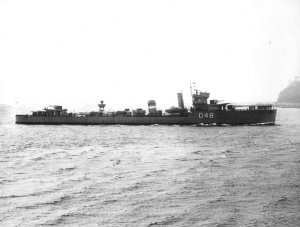HMS Gladiolus was a Flower-class corvette of the Royal Navy, the first ship of her class.

HMS Vidette (D48) was an Admiralty V-class destroyer of the Royal Navy. Built at the end of the First World War, she served in the final months of that conflict, and saw extensive service in the inter war years and in World War II. She was an effective convoy escort and U-boat killer, being credited with the destruction of five U-boats during the Battle of the Atlantic. HMS Vidette transported Spike Island Republican Prisoners to Bere Island Internment Camp in 1921. *Refer Spike Island’s Republican Prisoners, 1921 by Tom O’Neill MA.

HMS Scarborough was a Hastings-class sloop of the Royal Navy launched in 1930. She served in the Second World War, especially as a convoy escort in the North Atlantic.

HMS Woodpecker, pennant number U08, was a Black Swan-class sloop of the Royal Navy. She was active during the Second World War and was a successful anti-submarine warfare vessel, being credited with the destruction of six U-boats.

HMS Arbutus was a Flower-class corvette of the Royal Navy, which was active during the Second World War. She was a successful escort vessel, and took part in the destruction of two U-boats during the Battle of the Atlantic. Arbutus was torpedoed by a U-boat and sunk in the North Atlantic in February 1942 while aiding a convoy that was under attack.

HMS Bickerton was a Captain-class frigate of the Royal Navy. She served during the World War II as a convoy escort and anti-submarine warfare vessel in the Battle of the Atlantic and was an effective U-boat killer, being credited with the destruction of two U-boats during a service career of just 10 months. Bickerton was lost in action on 22 August 1944.

HMS Duckworth (K351) was a Captain-class frigate of the Royal Navy. She served during the Second World War as a convoy escort and anti-submarine warfare vessel in the Battle of the Atlantic and was an effective U-boat killer, being credited with the destruction of five U-boats during the conflict.
HMS Marigold was a Flower-class corvette of the Royal Navy. She was launched on 4 September 1940 and was sunk by an Italian air-dropped torpedo on 9 December 1942.

HMS Fowey was a Shoreham-class sloop of the Royal Navy. She served during the Second World War.

HMS Leith was a Grimsby-class sloop of the Royal Navy that served in the Second World War.
HMS Arabis was a Flower-class corvette of the Royal Navy. The ship was commissioned into the Royal Navy as HMS Arabis. She was transferred to the United States Navy in 1942, serving as USS Saucy. Returned to the United Kingdom in 1945, she was recommissioned into the Royal Navy as HMS Snapdragon.
The 2nd Escort Group was a British anti-submarine formation of the Royal Navy which saw action during the Second World War, principally in the Battle of the Atlantic.

HMS Keppel was a Thornycroft type flotilla leader built for the Royal Navy at the end of the First World War. She was completed too late to serve in that conflict, but saw extensive service in the inter war years and in World War II. She was an effective convoy escort and U-boat killer, being credited with the destruction of five U-boats during the Battle of the Atlantic. She was the second of three ships named for 18th century Admiral Augustus Keppel.

HMS Stork (L81) was a Bittern-class sloop of the Royal Navy. She was active during the Second World War, serving in convoy escort groups, and was a successful anti-submarine warfare vessel, being credited with the destruction of four U-boats.

HMS Wanderer (D74/I74) was an Admiralty modified W class destroyer built for the Royal Navy. She was the seventh RN ship to carry the name Wanderer. She was ordered in January 1918 to be built at the Fairfield Shipbuilding and Engineering Company, Govan in Glasgow, being launched in May 1919. She served through World War II where she was jointly credited with five kills on German U-boats, more than any other ship of her class. In December 1941 the community of Sutton Coldfield in Warwickshire officially adopted her. In 1943 she was one of twenty one V&W class destroyers to be converted as Long Range Escorts. She was decommissioned after the war and sold for scrap in 1946.

HMS Wren (U28) was a Black Swan-class sloop of the Royal Navy. She was active during the Second World War and was a successful anti-submarine warfare vessel, being credited with the destruction of five U-boats.

HMS Pelican (L86) was an Egret-class sloop, built for the British Royal Navy. She was active during the Second World War and was a successful anti-submarine warfare vessel, being credited with the destruction of four U-boats.

HMS Enchantress (L56) was a Bittern-class sloop, built for the British Royal Navy. She was the lead ship of her class, being laid down as Bittern, but renamed as Enchantress before being launched by Lady Jean Alice Elaine Cochrane. She was active during the Second World War, serving mainly as a convoy escort, and was a successful anti-submarine warfare vessel, being credited with the destruction of an Italian submarine in 1942.

Clive Gwinner (1908–1998) was a Royal Navy officer who served during the Second World War. He was a successful Anti-Submarine Warfare commander, being credited with the destruction of seven U-boats during the Battle of the Atlantic.

HMS Weston was a Shoreham-class sloop of the British Royal Navy. Weston was built at Devonport Dockyard in 1931–1933.
















